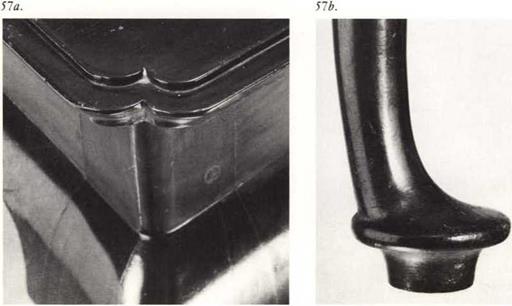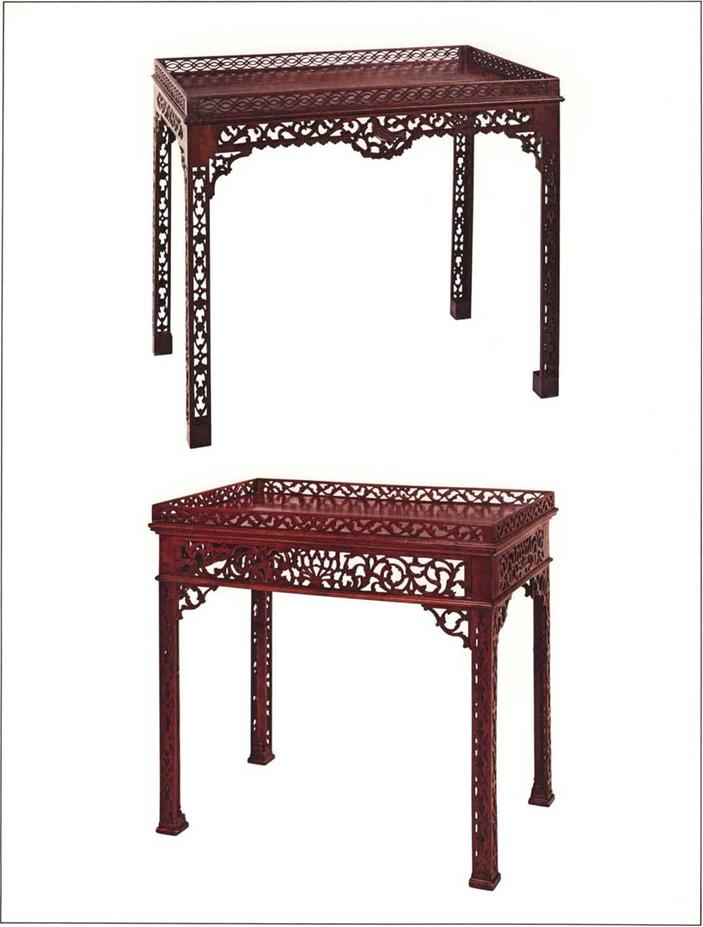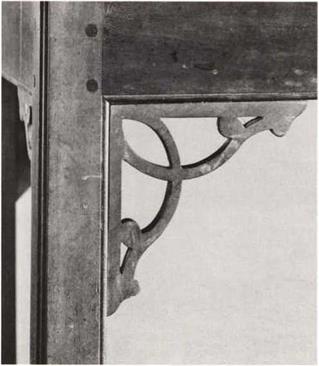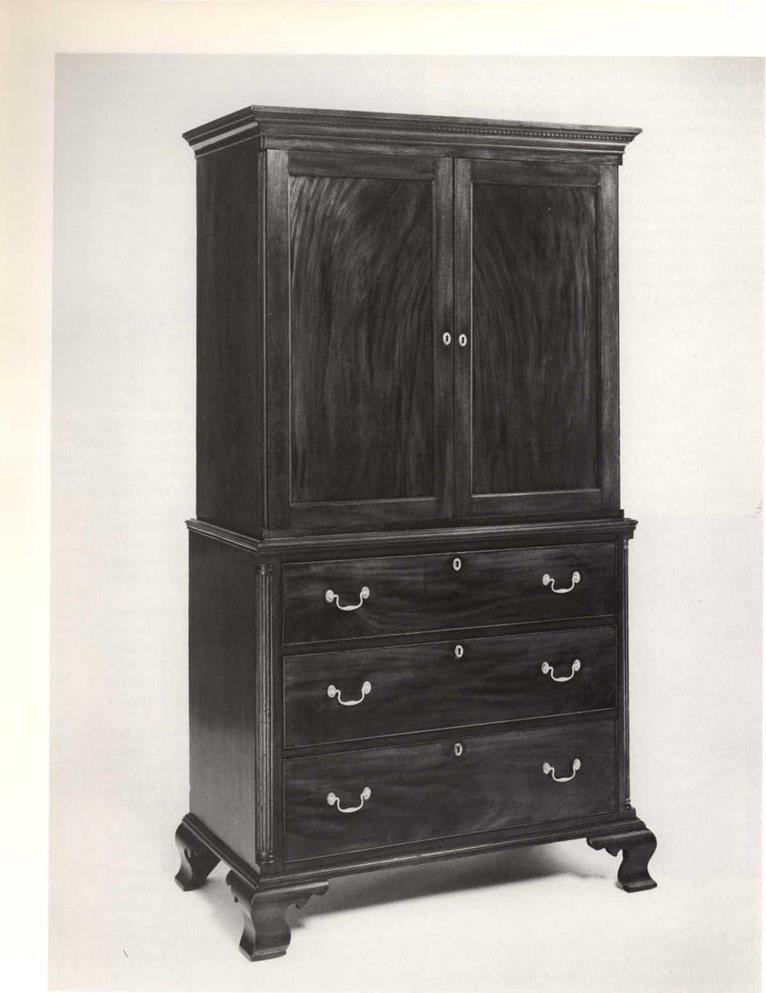A Masonic Master’s chair (fig. 49) signed by Benjamin Buck trout gives an undisputed look at high quality carved furniture produced in the I lay shop.’1’ Details of this signed chair have an affinity to those of the preceding three pieces, not an unexpected development considering Bucktrout’s association with I lay and his eventual ownership of the business.
The Bucktrout chair w as taken to the Kdenton, North Carolina Unanimity Lodge No. Seven in 1778, according to an entry in the minute books there. Further information on the piece is found in their library, w here a letter from Norfolk Lodge No. One, dated 1811, claims the chair and states that it was taken to Kdenton to save it from destruction by the British. Unfortunately it does not clarify w hich lodge in Virginia originally owned the chair before it was taken there for safekeeping. Another letter from the Norfolk Lodge, this one dated 1815, again claimed the chair, as did one in 1876 from the Alexandria Lodge. This latter claim was without validity, however, since the lodge was not in existence w hen the chair was taken to Kdenton. On October 6, 1877, the Raleigh Observer featured an article on the piece, noting its signature and establishing its maker’s position in early Williamsburg: “On the back of the chair is the odd name Benjamin Bucktrout. Capt. [Octavious] Coke [North Carolina Secretary of State J, who came from Williamsburg, says that Bucktrout is an immemorial patronymic of cabinetmakers in that old tow n.’ ”57
The overall design of this piece, which was created entirely for ceremonial purposes, is by far the most ambitious of all American Masonic chairs. Its elements have been scaled in proportion to the abnormal size, and the exceptional architectural quality of the back gives it a distinction not encountered in other American Masonic chairs.
The crest of the chair simulates a cut stone arch (fig. 49a), with a gilded scroll on its keystone and a book on top. Capping the central column is a magnificent bust of Matthew Prior (1664-1721) (fig. 49b), a rendering after a marble sculpture carved by the Frenchman Antoine Coysevox about 1700. The origin of the chair’s wooden bust has been questioned, and Philadelphia has been suggested as its source,58 but close study reveals that the features of the masks on the moon and the sun that Hank the bust are executed in the same style and appear to be by the same carver. The sculpting of the lips and the areas around the corner of the mouth show the same approach and techniques of modeling as do the eyes.

49. Masonic Master’s Chair, attributed to the Anthony Hay Shop, stamped signature of Benjamin Bucktrout, Williamsburg, 1767-1770.
Mahogany primary; walnut secondary, original black leather upholstery.
Height 65Vi", width 3114", depth 29Уг".
1’he Unanimity Lodge No. 7, Edenton, North Carolina.
![]()
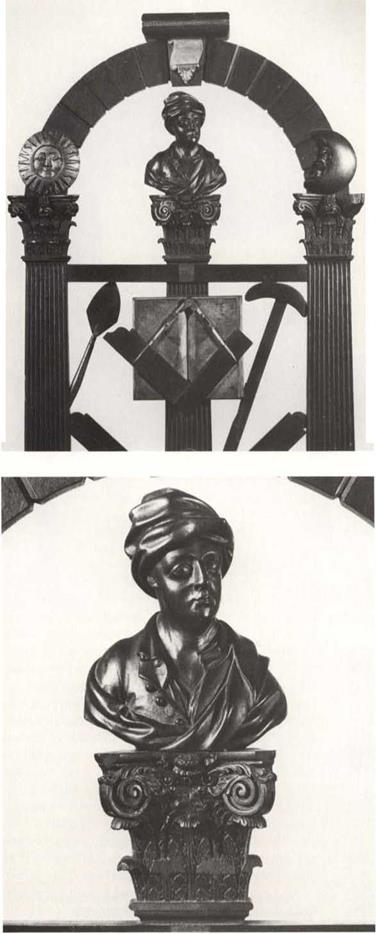
w ith their exaggerated lids extending over the sides of the eyeballs. In addition to this sculptural affi nity, these three elements—sun, moon, and bust—are critically linked with the scale and design of the curved arch and Hanking columns. This evidence indicates that the chair was conceived as a total unit and produced by Bucktrout, or under his supervision. The existence of another chair from this shop, with sculptural carving equal to that of the bust, is further support for this conclusion (tig. 46).
W hile the exact design source for the bust is unknown, the dolphin legs (tigs. 4Vg, 49h) derive from plate XXI of Chippendale’s Director, possibly from the same copy that appeared in F. dmund Dickinson’s inventory several years later. In contrast, the design for the arm supports is from I lay shop examples of a decade or more earlier. I he acanthus originates at the outside base of the supports, then runs upward and folds back upon itself (fig. 49d), modified from the heavily curled acanthus found on the Capitol chair support (figs. 46b, 46c). I’hc acanthus found on the Capitol chair arm support and on the closely related Lodge Six chair (fig. 47c), how ever, flow from a pair of small volutes that flank the lower corner of the support. ‘This configuration allows the acanthus to flow upon both outside faces. In the Bucktrout example a different support was used, featuring a piercing through its lower outer edge.59 The carver, unable to adjust to this change, attempted to execute the acanthus from the side, as in the tw о earlier chairs, even though the stem of the acanthus conflicted w ith the position of the piercing. With no area to complete the stem as a volute, it was cut off squarely, and results in an aw kwardly finished product. The veining of this acanthus also shows a degenerate relationship compared with those of the Capitol and Lodge Six chairs. The delicate, flow ing character on the Capitol chair is executed with a fine gouge that was skillfully handled and produced a surface of parallel and converging flutes. This same technique w as used on the Lodge Six chair (fig. 47), although executed w ith less skill. With deeper veining and a greater accent on the flutes, the carving of the Lodge Six chair does not show the flowing quality of the Capitol example. This rigid contrast is more accented on the Bucktrout acanthus; the carving has deep, wide, concave flutes separated by high, narrow ridges. In a naive attempt to achieve the delicacy of the earlier work, the carver has added small veins to his harshly modeled foliage. An early stage of this decline from academic design can be seen in veined foliage on the Lodge Six chair back (fig. 47b). This loss of style and skill parallels that previously discussed regarding the lion’s heads of the Capitol and Lodge Six chairs.
|
|
Other close relationships to the Lodge Six chair are found in the endings of two large acanthus leaves which flank the central “ruffled shell’’ pendant of the skirt on the Bucktrout chair (fig. 49f). These two fronds end very abruptly, leaving a space between their tips and the shell ornament. This same abrupt ending is seen on the arm support of the Lodge Six chair(flg. 47c, 47d). In both examples the addition of an extended point, or of a curled overlap, would balance the weight of the overall design. Another similarity between these two chairs is seen in the crisp C-scrolls above the dolphin’s head (fig. 49g) and on the central skirt, and those of the knee carving of the Lodge Six chair (fig. 47e).
In view of the foregoing discussion, the Buck – trout chair appears to be the product of at least two tradesmen, perhaps even more. The bust and the Masonic symbols exhibit extremely high quality carving, while the arm supports are poorly executed in comparison. The skirt carving has hollowed-out features and a harshness of outline seen in the arm supports, although it displays better workmanship. The involvement of several carvers in such an extensive effort is certainly understandable, and it is quite likely if considered in light of what is known about the Hay shop and the practice of craft specialization in the eighteenth century.
The collective study of these three chairs and the ball-and-claw-foot card table provides firm evidence for several very important conclusions. The interrelationship of their designs and their carved elements show the Capitol chair to be a product of the Hay shop and not an English piece, as it was assumed to be in the past. The various design elements that unite this group are not imitations of a single prototype, but examples of a firmly developed style that evolved over a period of two decades— precisely the case seen in the arm supports of these chairs. Likewise, the Lodge Six animal feet and knee carving arc not copies from the Capitol chair. They are variations within the George II style, with enough individual characterization to make their affinity to each other clear, yet distinguishable from examples produced elsewhere.
The signed Bucktrout chair and the ball-and – claw-foot card table establish Hay’s shop as the origin of the Capitol chair. Its mid-century style coincides w ith the rebuilding of the Capitol in the early 1750s, thus providing strong circumstantial evidence to attribute the carving to James Wilson, the London-trained artisan who was working for I lay in 1755. Certainly the quality and style of this carving supports a London association.
The Lodge Six chair represents an intermediate stage between the Capitol and the Bucktrout examples. It also appears to have been made after the uncertain date of departure of James Wilson, the London carver who worked with I lay. The carving, although fine, would be hard to accept as having been executed by the same hand that executed the Capitol chair, and it probably represents the impact of Wilson’s style and training on I lay shop products (see footnote 55).
The signed Bucktrout chair was probably made during his ow nership of the I lay business (1767-70). Its numerous designs, which relate to earlier I lay production, have already been pointed out. It is also known that elements were taken from Chippendale’s Director, a copy of which is documented in the shop during Edmund Dickinson’s time and which possibly had been there since 1 lay’s active practice of the craft. We have also seen that Dickinson and “Wiltshire’’ probably remained with the I lay business when Bucktrout returned in 1767, which means they would have retained a knowledge of earlier 1 lay shop design and technique. While none of these reasons alone is indisputable proof, collectively they point to the Bucktrout chair as a product of the I lay shop between 1767 and 1770.
 |
50. Dressing Chest, attributed to the Anthony Hay Shop, probably Benjamin Bucktrout, circa 1770.
Cherry primary; yellow pine and cherry secondary.
Height 72", width 40", depth 21".
Mr. and Mrs. Malcolm Jamieson.
|
50а. |
|
50b. |
The next three pieces of furniture are attributed to Bucktrout on somewhat tenuous grounds, and their separation from other Hay shop production is difficult. The first example is a dressing chest made of cherry, with yellow pine and cherry secondary woods (fig. 50).eo The Bucktrout attribution is based on the fret design in its cornice. Before a discussion of this fret, however, there are several features of the chest that should be noted since they are associated with the Scott group and are otherwise unknown in Virginia furniture. The chest is breakfront in form (the bottom section is deeper than the top and therefore forms an offset at their juncture) and the top had a cut-through gallery above its cornice—two features already seen on a clothespress at Blandficld that clearly falls within the Peter Scott group (fig. 42). The indented corners on the raised panel doors are also similar in design and execution to those of the Scott group.
The fret beneath the cornice of this dressing chest (fig. 50a) features four-petalled flowers w ith centers formed by a drilled hole. Two “china tables” (Chippendale’s definition for the form) also attributed to the Hay shop have a series of identical flowers in the design of their legs (figs. 51b, 52). In addition, they have a guilloche-like detail that originates from these flowers, w ith small lobes in matching pairs, that give a floral quality quite unlike the more frequently encountered geometric designs. This same floral guilloche is carved in relief between the pilasters of the Lodge Six chair (fig. 47b), although there it is more complex than on the fretwork tables. This is probably due to the differences in techniques: carving certainly gives more detail, but its employment in a fret might cause problems of execution and strength. Despite these differences, the basic designs of these three pieces are the same and thereby further emphasize their relationship.
In addition to this fret design, the overall plan of the skirt on the china table (fig. 51) is closely associated w ith that on the Bucktrout chair (fig. 49f). Both have a pronounced central element, with scalloping that is similarly handled: they have a harshness of outline and modeling that, in the Bucktrout chair, is most pronounced in the carved ruffled shells that flank the knees and that surround the C-scrolls in the center skirt. In these examples the outline of the shells is symmetrically composed, with an edge that repeats a cove followed by a projecting astragal. This is quite unusual in rococo design, where shells generally display a flow ing form and are most often very asymmetical. The Capitol chair knee carving (fig. 46e) features a flow ing ruffled shell that drapes naturally over the knee, w hile that of the I>odge Six chair (fig. 47e) is stiffer and lacks a spontaneity of line. The splashing convex teardrops in the Capitol chair’s tattered shell projects great movement in contrast to those of the Lodge Six chair; here, they have lost their effective motion and are executed in a much coarser manner. The ruffled shells of the Bucktrout chair display an even greater loss and have an extremely simplistic approach, show ing yet another w ay in w hich it relates to the Capitol chair, with the Lodge Six chair of a quality between the two. Since the dolphin-legged chair in Chippendale’s Director has a standard, flowing, asymmetrical shell quite unlike that of Bucktrout’s, it is thus likely that these chairs arc related by similar design and conception. The scalloped skirt of the Byrd china table (fig. 51) is also harshly designed in the Bucktrout style and contrasts vividly with the representative flow ing character seen on the central skirt of an English china cabinet (fig. 41).
The cherry dressing chest (fig. 50), the only known example from Virginia, has a fully developed dressing drawer in the top of the low er section (fig. 50b). The drawer is cherry throughout, and in its center is a reversible platform w ith a looking glass on
|
|
one side and on the other a w riting surface originally covered with leather or felt. This platform is raised and lowered on a ratchet and is Hanked by numerous compartments and small drawers. The cover of one compartment on the right has a block-like handle that is slotted for holding rings. 1’hc design of this draw er is similar to one in plate LI I of Chippendale’s Director, which is described as having “a Glass made to rise, and hung w ith I linges. . . Places for Combs, Rings, Bottles, Boxes, &e. . . .”61 Originally, two long horizontal strips were attached to the back of this drawer. They extended beyond its sides and slid into slots cut in the insides of the case. They served as “stops” to prevent the draw er from pulling too far out.

 This chest has three regular drawers beneath the fitted one. Each is constructed w ith a bottom having a slight bevel around three faces and is fit into grooved sides. Three long blocks, approximately one inch apart and mitered at the corners, arc glued to the bottom against the front edge. The side blocks that formed the draw er runners are missing, and it is not clear if they were continuous or segmented. The bottoms are secured to the back with several small Lor Г-head nails.
This chest has three regular drawers beneath the fitted one. Each is constructed w ith a bottom having a slight bevel around three faces and is fit into grooved sides. Three long blocks, approximately one inch apart and mitered at the corners, arc glued to the bottom against the front edge. The side blocks that formed the draw er runners are missing, and it is not clear if they were continuous or segmented. The bottoms are secured to the back with several small Lor Г-head nails.
The lower case has dust partitions between the drawers. The partitions are as thick as the drawer blades and continue the full depth of the case. This form of dustboard is termed “full bottom” by the Lnglish furniture historian R. YV. Symonds, and is seen in a number of other YY’illiamsburg pieces.62 These dust partitions fit into grooves that arc cut in the sides of the case and are sporadically wedged with narrow pieces of cherry approximately one inch w ide; the wedges are driven in from below to tighten them. The feet and base molding are replacements.
The interior of the upper section was constructed w ith numerous drawers—some of which are now missing—and central shelves. The section’s well-designed door has pilasters that Hank a large, well-proportioned, raised panel. The pilasters are attached by wood screws, which enter from the back; their stop Huting may be associated w ith that on the signed Bucktrout and Lodge Six chairs (figs. 49, 47b). The cornice is detachable, separating just below the fret, and although the gallery at the top is a replacement, the low er section of the original survives. These suggest that it had a guillochc design similar to that seen on the follow ing table.
This china table (fig. 51) is made completely of mahogany, and has a bold quality that distinguishes it from British examples. Each leg is cut from a solid piece of wood, as is the gallery—w hich in English pieces is often triple-laminated. The table originally stood slightly higher and probably had molded block
feet as well as columns inside each leg (see fig. 52 for comparison). It was made without secondary wood but now has several white pine blocks beneath the top, possibly put there during the late nineteenth century when the piece was in Baltimore. These blocks, clearly not original, contain nail holes from previous usage. The glue smears that accompany them are of a much later date than the table’s original construction.
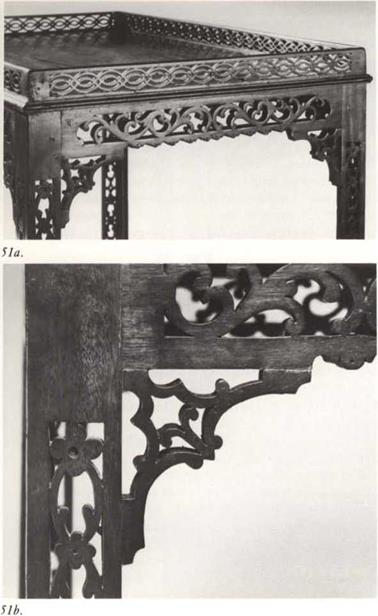 An oral tradition associated with this table reveals that it descended through the Lew is family of Gloucester County, Virginia. Susan Lewis married William Powell Byrd, son of William Byrd III of Westover. The bird featured in the skirt (carved only on one side) may w ell be an indication of the latter family’s connection.63
An oral tradition associated with this table reveals that it descended through the Lew is family of Gloucester County, Virginia. Susan Lewis married William Powell Byrd, son of William Byrd III of Westover. The bird featured in the skirt (carved only on one side) may w ell be an indication of the latter family’s connection.63
Closely related to this table is a similar but more elaborate piece w ith skirt and legs of cherry and a top of curly maple (tig. 52). The fret of the legs is a slight variation of the type of the Byrd table, strengthening their association w ith carving on the Lodge Six chair back. The floral guilloche has double lobes in each segment, and at the top of each leg the last piercings develop into confronting lobate leaves—variations closer to the Lodge Six chair carving than the Byrd table.
Unfortunately, several of the leg brackets and the pierced gallery are replacements, and it is not know n if the gallery is a copy of the original. The original gallery may have had a complex guilloche design similar to that on the Byrd table, which would better complement the overall design than the replacement. The quality of this gallery is vastly inferior to the piercing in the skirt and leg, where the masterful use of the fret saw can be seen. Every portion is cut with assurance and sharpness, creating fine lines that produce a flowing quality in the foliage. The replacement fret is crudely executed and displays a tremendous misunderstanding of the design.
Several other details on this table are also seen on the Byrd table. One that is particularly distinguishable is a small shoot that ends in three bulbous lobes; it is found on the lower corners of the front skirt. This detail is also present on the skirt of the Byrd table, located just in front of, and touching, the bird’s beak. Also, this example, like the Byrd table, is symmetrical, with only a small element establishing a “front.” I lere the two front legs have a very small bead carved down their corners, a feature that is omitted on the back. Likew ise, the Bvrd table has only one bird carved, while the other is simply cut in profile.
The top of this table is curly maple, a wood that is rare in southern furniture and even more so in the
 |
products of eastern Virginia. Seen here, quarter- sawn and book-matched, it is certainly indicative of the traditional approach to the construction of a fiddle back, further reinforcing the possibility that Bucktrout was a musical instrument maker.
There is a third china table in this group that relates to the previous piece through its well – executed piercings, but this example has the addition of a delicately cut cross-stretcher. I. ike the preceding table, it was among the collection formed by Lewis G. Myers, the great furniture connoisseur of the early twentieth century, but its location is currently unknown. The catalogue for the sale of his collection notes that this table “. . . stood in a V irginia home one hundred and Hfty years, and w as doubtless the work of an American craftsman.”64 These three pieces are the most fully developed American fretwork china tables known. Their line proportions, superb piercings, and free-standing columns distinguish them from other American examples of the same form.
Another piece w ith mixed primary woods is a dressing table of delicate scale (fig. 53). Principally of cherry, but having drawer fronts of mahogany, it has a top with indented corners like those on a tea table in this group (fig. 57). The bead molding on the skirt is related to those in the following examples, and the chamfered and fluted corners of the case are an effective refinement. Its long, graceful legs are quite similar to those of a much earlier tea table (fig. 8) and a card table (fig. 48), the latter having beading on the knees that also relates to this piece. The volutes, w hich are relatively weak in design, overlap the rails of the skirt as seen in the Bucktrout chair and later examples from the I lay shop. The ball-and-claw feet are essentially of the Scott group type, with flattened ball and concave rear toe. Their finely knuckled front toes, though somewhat unusual, seem to be a combination of the Scott foot anil the type on the I lay shop card table (fig. 48b).

 |
A small side tabic (fig. 54) is characteristic of much furniture from eastern Virginia in its simplicity. It is an original furnishing at the College of William and Mary, although the date it entered the collection is unknown. It is made of walnut with yellow pine and has the original brass. The Williamsburg provenance, together w ith drawer construction resembling the large dressing chest (fig. 50), are reasons for including it in the Bucktrout group. Across the bottom of the skirt is a small bead that continues dow n the outside edges of each leg. This bead is also found on the finished skirt of the w alnut back, although the molded edge of the top does not continue there, indicating that the table was intended for use against a w all. The top is glued to the frame w ith small pine blocks that are spaced a few inches apart.
A cherry side table closely related to the preceding example has an identical attachment for the top and the same fine bead on the legs and skirt (fig. 55). I he rear skirt is also completely finished, and the top is molded across the back. Again, the intent was to place the table against a wall, for despite considerable w ork in finishing all four sides, the rear brackets arc not pierced. The unusual feature of the finished back w ith unfinished brackets presents an important tie between the two china tables (figs. 51,52) and these side tables (figs. 54, 55). The top is attached w ith a number of small blocks, which also relates to the preceding example. This table descended in a family of Westmoreland County, Virginia.
|
55a. |
A magnificent clothespress, once owned by the I laxall family of “Straw berry Hill” in Petersburg, shares many features w ith Williamsburg cabinetwork, some of which relate it to Bucktrout (fig. 56). The lower case, constructed with full-bottom dustboards, is virtually identical to that of the cherry dressing chest (fig. 50). As in the dressing chest, the dustboards are tightened w ith an occasional narrow wedge driven from beneath. The feet are replacements, although the original base molding and some of the support blocks survive—enough in fact, to determine that the original feet were ogee brackets. The partially surviving blocks indicate that the foot construction was of the composite type, w hich is also seen on Scott examples and is common in other Williamsburg groups. The molding at the base and at the top of the lower case has rounded corners, which conform to the previous pieces. The drawer construction also relates this press to the dressing chest: the bottoms are set in grooves with short blocks glued to support them, although the blocks arc not mitered at the corners and are more numerous.
The top section of this clothespress is fitted with five sliding trays and two small drawers; all the bottoms are constructed like those of the low er case drawers. A difference in construction, however, is found in the single dust partition above the two drawers. Made of very thin red cedar, it is held in place by a strip of yellow pine running from front to back—the same method employed in all the Scott group case pieces (fig. 37d).
The sliding trays for storing clothing have mahogany fronts and red cedar linings. Cedar was undoubtedly used because of its qualities as an insect repellent. It is also found in the fitted desk interior of the lower section; the draw er fronts here arc covered w ith a one-eighth inch veneer of crotch mahogany (fig. 56b).
This piece also has yellow pine tops and bottoms on each case, some small elements of poplar, and backs of tonguc-and-groove black w alnut. The w alnut provides another association with Bucktrout, who employed it for secondary usage on his signed Masonic Master’s chair.
In certain details, this clothespress resembles the cherry dressing chest recently discussed (fig. 50): both have fitted drawers in the lower sections and cupboards in the tops. The doors of this piece are English in construction with joints similar to those on drop-leaf tables, stopping them at a right angle when they are opened. The press is also unusual for having a desk interior combined with a cupboard and for using sliding trays for clothing storage, a design also closely related to English chest-on-chests. One
|
|

basic difference between these two chests is the construction of the cornice. On the clothespress it is glued directly to the case, and on the dressing chest it is detachable.
Several features of this piece might suggest a rather late date. Some of those features, in fact, are usually considered to be indications of federal period production. The flat panels of the doors and the fitted desk drawer with hinged front are usually associated w ith cabinetmaking in the late eighteenth or early nineteenth century. Flat panels appear on F. nglish pieces from the 1760s, however, and the Norfolk clothespress dated 1775 is a definite example of their use in pre-Revolutionary Virginia (fig. 105). Another early example from Williamsburg also exists (fig. 77), and like this one it has ogee spandrels in the upper corners of its flat panels, a trait that appears to indicate their early date. Fitted desk drawers, like flat panels, arc also most commonly seen on federal furniture; however, they clearly appear before that date, and the form is known to have been used in Charleston, South Carolina during the 1770s.*5 This fitted draw er (fig. 56b) differs from later ones by the use of a brass hook-and-eye latch to keep the drawer front closed, instead of the later push-button mechanism, thus suggesting that this form is an earlier stage in its development.
As stated earlier, the attribution of these six pieces to Bucktrout is very tentative (figs. 50-56). The case is stronger with the earlier examples and they may actually precede Bucktrout and represent Anthony Hay production. Collectively, this furniture exhibits strong evidence of Williamsburg origin in light of its interrelationship with the signed Bucktrout chair and with other Williamsburg groups.
56. Clothespress, attributed to the Anthony Hay Shop, Williamsburg, circa 1775.
Mahogany primary; yellow pine, red cedar, poplar, and walnut secondary.
Height 8ПА", width 47 V»", depth 25 V»".
The Colonial Williamsburg Foundation (acc. no. G1977-228), gift of Miss Martha B. D. Spotswood.
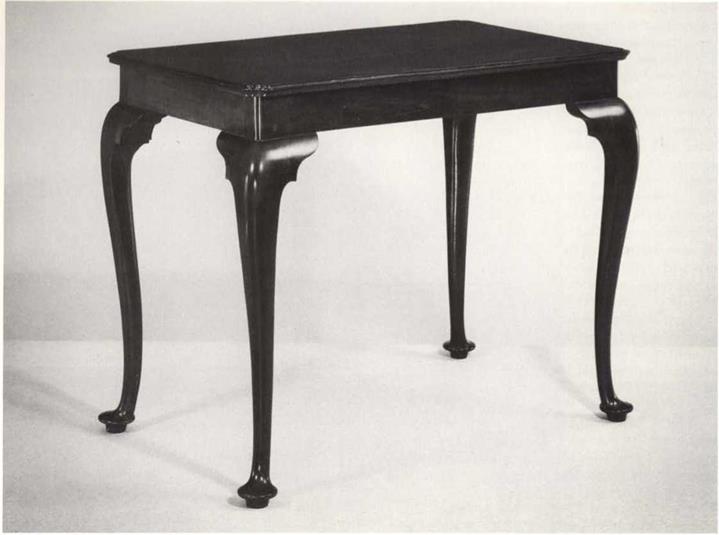
|
